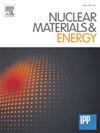EUROFER RAFM钢在550°C锂陶瓷下的应力腐蚀开裂(SCC)
IF 2.7
2区 物理与天体物理
Q1 NUCLEAR SCIENCE & TECHNOLOGY
引用次数: 0
摘要
本研究研究了当暴露于锂陶瓷增殖材料(HCPB环境)550℃时,EUROFER低活化铁素体-马氏体(RAFM)钢对应力腐蚀开裂(SCC)的敏感性。采用标准化的实验方法,在保持微观结构完整性的同时,对u型弯结构施加明确的应力。样品经受长时间暴露(长达4300小时)与锂陶瓷直接接触,并使用扫描电子显微镜(SEM)和能量色散x射线光谱(EDX)表征所造成的损伤。进行了互补有限元模拟,以确保施加的载荷保持在弹性范围内,评估应力分布,并确定承受最大应力的区域。结果表明,高温氧化导致的薄而脆的贫铬表面层的形成促进了SCC的发生。裂纹在这个化学和结构退化的区域内成核,并在残余应力作用下穿晶扩展。对裂纹密度和尺寸的定量分析表明,裂纹密度和尺寸与暴露时间和应力水平有明显的相关性,证实了机械载荷在加速裂纹萌生和扩展中的关键作用。这些发现确定了在增殖毯运行条件下影响EUROFER的重要降解机制,强调了控制表面化学和残余应力以确保长期结构可靠性的必要性。本文章由计算机程序翻译,如有差异,请以英文原文为准。
Stress corrosion cracking (SCC) in EUROFER RAFM steel subjected to Li-ceramics at 550 °C
This study investigates the susceptibility of EUROFER reduced-activation ferritic-martensitic (RAFM) steel to stress corrosion cracking (SCC) when exposed to lithium ceramic breeder materials (HCPB environment) at 550 °C. A standardized experimental methodology based on the U-bend configuration was employed to apply well-defined stresses while preserving microstructural integrity. Specimens were subjected to prolonged exposure (up to 4300 h) in direct contact with lithium ceramics, and the resulting damage was characterized using scanning electron microscopy (SEM), and energy-dispersive X-ray spectroscopy (EDX). Complementary finite element simulations were performed to ensure the applied load remained within the elastic regime, evaluate the stress distribution, and identify the region experiencing maximum stress.
The results reveal that SCC is promoted by the formation of a thin, brittle, chromium-depleted surface layer, resulting from high-temperature oxidation. Cracks nucleate within this chemically and structurally degraded zone and propagate transgranularly under residual stress. A quantitative analysis of crack density and size demonstrates a clear correlation with exposure time and stress level, confirming the critical role of mechanical load in accelerating crack initiation and growth. These findings identify a significant degradation mechanism affecting EUROFER in breeder blanket operating conditions, underscoring the need to control both surface chemistry and residual stresses to ensure long-term structural reliability.
求助全文
通过发布文献求助,成功后即可免费获取论文全文。
去求助
来源期刊

Nuclear Materials and Energy
Materials Science-Materials Science (miscellaneous)
CiteScore
3.70
自引率
15.40%
发文量
175
审稿时长
20 weeks
期刊介绍:
The open-access journal Nuclear Materials and Energy is devoted to the growing field of research for material application in the production of nuclear energy. Nuclear Materials and Energy publishes original research articles of up to 6 pages in length.
 求助内容:
求助内容: 应助结果提醒方式:
应助结果提醒方式:


